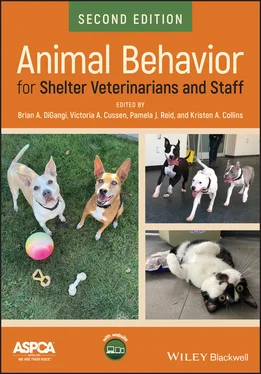Animal Behavior for Shelter Veterinarians and Staff
Здесь есть возможность читать онлайн «Animal Behavior for Shelter Veterinarians and Staff» — ознакомительный отрывок электронной книги совершенно бесплатно, а после прочтения отрывка купить полную версию. В некоторых случаях можно слушать аудио, скачать через торрент в формате fb2 и присутствует краткое содержание. Жанр: unrecognised, на английском языке. Описание произведения, (предисловие) а так же отзывы посетителей доступны на портале библиотеки ЛибКат.
- Название:Animal Behavior for Shelter Veterinarians and Staff
- Автор:
- Жанр:
- Год:неизвестен
- ISBN:нет данных
- Рейтинг книги:5 / 5. Голосов: 1
-
Избранное:Добавить в избранное
- Отзывы:
-
Ваша оценка:
- 100
- 1
- 2
- 3
- 4
- 5
Animal Behavior for Shelter Veterinarians and Staff: краткое содержание, описание и аннотация
Предлагаем к чтению аннотацию, описание, краткое содержание или предисловие (зависит от того, что написал сам автор книги «Animal Behavior for Shelter Veterinarians and Staff»). Если вы не нашли необходимую информацию о книге — напишите в комментариях, мы постараемся отыскать её.
A comprehensive resource to understand the behavioral considerations for intake, management, and rehoming of dogs and cats Animal Behavior for Shelter Veterinarians and Staff
Animal Behavior for Shelter Veterinarians and Staff — читать онлайн ознакомительный отрывок
Ниже представлен текст книги, разбитый по страницам. Система сохранения места последней прочитанной страницы, позволяет с удобством читать онлайн бесплатно книгу «Animal Behavior for Shelter Veterinarians and Staff», без необходимости каждый раз заново искать на чём Вы остановились. Поставьте закладку, и сможете в любой момент перейти на страницу, на которой закончили чтение.
Интервал:
Закладка:
13 Appendix A: Canine Body LanguageA Neutral Relaxed B Greeting Behavior C Initial Greeting D Play Solicitation E Arousal F Offensive Aggression G Defensive Aggression H Maternal Aggression I Crouch J Roll Over
14 Appendix B: Feline Body LanguageA The Confident Cat B The Confident Cat: At Ease C Distance‐Reducing Behaviors D Distance‐Increasing Behaviors E The Anxious Cat F Defensive Aggression G The Predator H The Groomer
15 Appendix C: Animal Behavior ProfessionalsAcademy of Veterinary Behavior Technicians—www.avbt.net American Board of Veterinary Practitioners—Shelter Medicine Practice—https://abvp.com/ Applied Animal Behaviorist Certified Professional Dog Trainer (CPDT)—www.ccpdt.org Trainer Veterinarian Veterinary Behaviorist—www.dacvb.org
16 Index
17 End User License Agreement
List of Tables
1 Chapter 3 Table 3.1 The four contingencies in operant conditioning. Table 3.2 Reinforcement schedules. Table 3.3 The ABCs of behavior analysis.
2 Chapter 4 Table 4.1 Common Stressors and Behavioral Signs of Stress in Shelter Dogs a... Table 4.2 Behavioral signs of pain in dogs and cats (Mills et al. 2020; Bac... Table 4.3 Endocrinological disorders that may lead to behavioral changes.
3 Chapter 5 Table 5.1 Sources of program‐planning information.
4 Chapter 9Table 9.1 Behavior evaluations in the published literature.
5 Chapter 10Table 10.1 Key considerations for in‐shelter housing selection.
6 Chapter 15Table 15.1 Advantages and disadvantages of frameworks for assessing behavio...Table 15.2 Types of reliability and validity.
7 Chapter 19Table 19.1 Common ethical decision‐making frameworks (Mullan and Fawcett 20...Table 19.2 Generic ethical matrix for animal shelters *Table 19.3 Example ethical matrix for making a dog available for adoption....
8 Chapter 20Table 20.1 Common physical conditions and potential impacts during relocati...Table 20.2 Behavioral health considerations for animal relocation programs ...
9 Chapter 22Table 22.1 Behavioral medicines for shelter use.Table 22.2 Location and function of serotonin (5‐HT) receptors.
10 Chapter 23Table 23.1 Supplemental sources of vitamin C for guinea pig diets.
11 Chapter 25Table 25.1 Commonly reported post‐adoption behavioral concerns in dogs and ...
List of Illustrations
1 Chapter 1 Figure 1.1 Body parts that contribute to canine visual communication.
2 Chapter 2 Figure 2.1 Tail up greeting display. Figure 2.2 Defensive position. Figure 2.3 Kitten object play.
3 Chapter 3 Figure 3.1 A pigeon in a modern, touch‐screen‐equipped operant chamber.
4 Chapter 4 Figure 4.1 This diagram depicts how genetics, the environment, and medical c...
5 Chapter 5 Figure 5.1 Program development and management considerations. Figure 5.2 Example strategic decision‐making matrix.
6 Chapter 7Figure 7.1 Using a toothbrush to interact safely and with less stress for a ...Figure 7.2 This is a candidate for the “Tiny Spirit” kitten program.Figure 7.3 A “Tiny Spirit” kitten in a burrito wrap for safe handling, weigh...
7 Chapter 8Figure 8.1 Simultaneous use of control pole and slip lead for handling of a ...Figure 8.2 Slip lead with release leash attached.Figure 8.3 Correctly fitted slip lead.Figure 8.4 Correct slip lead handling position.Figure 8.5 A slip lead positioned for use as a leash harness.Figure 8.6 Finger lock.Figure 8.7 Thumb lock.Figure 8.8 An accordion leash hold can be formed by folding the leash into “...Figure 8.9 “Control position” for restraining a dog that is attempting to bi...
8 Chapter 9Figure 9.1 Walking on city streets exposes the shelter dog to a variety of e...Figure 9.2 A large dog learning to play with a small dog during playgroup....Figure 9.3 A visualization of how the various sources of behavioral informat...
9 Chapter 10Figure 10.1 Example of single unenriched cage where there is insufficient sp...Figure 10.2 Example of single enriched dog housing. This space would be suit...Figure 10.3 Example of one compartment of a double‐sided enclosure. Note the...Figure 10.4 Example of a traditional double‐sided enclosure providing indoor...Figure 10.5 Example of single enriched dog housing with three small dogs. No...Figure 10.6 Example of a basic outdoor exercise enclosure with a concrete fl...
10 Chapter 12Figure 12.1 These timid dogs are learning to interact with people in a home‐...Figure 12.2 A dog waits for the Pet Tutor TMto deliver food.Figure 12.3 An ASPCA Behavioral Rehabilitation Center staff member walks a f...Figure 12.4 An undersocialized dog at the ASPCA Behavioral Rehabilitation Ce...Figure 12.5 A group training session at the Canine Center Florida in which d...Figure 12.6 Hansel, a Canine Center Florida graduate, working as an arson de...
11 Chapter 13Figure 13.1 Recommendations for least intrusive to most intrusive stimuli us...Figure 13.2 Small (A) and large (B) dog playgroups. Shelter playgroups can v...
12 Chapter 14Figure 14.1 A handler restrains a cat on his side by holding the scruff of h...Figure 14.2 Most socialized cats enjoy being rubbed and scratched around the...Figure 14.3 This series of photos illustrates the use of a towel wrap to fac...Figure 14.4 Commercially available cat tongs. Tools such as cat tongs, contr...Figure 14.5 The way in which a cat carrier is held and carried impacts the e...Figure 14.6 The handler is holding the carrier in front of her body close to...Figure 14.7 A. A commercially available cat den (Tomahawk Live Trap, Hazelhu...Figure 14.8 A cat is safely and humanely transferred from a box trap to a ca...Figure 14.9 A. By raising and lowering the guillotine doors, a cat is safely...Figure 14.10 A. Commercially available “hand shield” for use with a cat den ...Figure 14.11 A Freeman cage net (Animal Care and Equipment Services [ACES], ...Figure 14.12 A. A commercially available box trap (Tomahawk Live Trap, Tomah...Figure 14.13 Commercially available drop trap, which is fully collapsible fo...Figure 14.14 A. Commercially available trap divider (Tomahawk Live Trap, Haz...Figure 14.15 An oral suspension of gabapentin is administered to a community...Figure 14.16 A. This cat is standing on his hind legs as the handler uses hi...
13 Chapter 15Figure 15.1 The four mini‐tests on the ASPCA’s Feline Spectrum Assessment: A...Figure 15.2 Cat‐Stress‐Score in response to provision of a social companion ...
14 Chapter 16Figure 16.1 Elevated cage bank.Figure 16.2 Portalized, double‐compartment housing.Figure 16.3 Portal installed into existent stainless‐steel caging thereby co...Figure 16.4 Dog kennel converted into walk‐in cat housing.Figure 16.5 Custom‐built walk‐in cat housing.Figure 16.6 Hiding place allowing cat to face outward.Figure 16.7 Elevated bed creating both a hiding place and a perching spot....Figure 16.8 Partial cage front covering offering a choice to retreat.Figure 16.9 How to set up a low‐stress primary enclosure.Figure 16.10 Group‐housing with environmental enrichment.
15 Chapter 17Figure 17.1 Feeding enrichment with the use of a puzzle feeder (Stimulo Cat ...Figure 17.2 Using desensitization and counter‐conditioning to socialize a ki...Figure 17.3 Organization of cat enrichment toys to ensure a daily rotation o...Figure 17.4 Location of scent glands on the feline head.Figure 17.5 An enriched cat housing environment funded by a corporate sponso...
16 Chapter 18Figure 18.1 Treat selection—offer various treats to determine preference.Figure 18.2 Initial approach using pom‐pom sprayed with feline facial pherom...Figure 18.3 Gradual introduction to the hand by moving hand farther down the...Figure 18.4 Desensitization and counter‐conditioning to being petted by the ...Figure 18.5 Desensitization and counter‐conditioning to being petted by the ...
Читать дальшеИнтервал:
Закладка:
Похожие книги на «Animal Behavior for Shelter Veterinarians and Staff»
Представляем Вашему вниманию похожие книги на «Animal Behavior for Shelter Veterinarians and Staff» списком для выбора. Мы отобрали схожую по названию и смыслу литературу в надежде предоставить читателям больше вариантов отыскать новые, интересные, ещё непрочитанные произведения.
Обсуждение, отзывы о книге «Animal Behavior for Shelter Veterinarians and Staff» и просто собственные мнения читателей. Оставьте ваши комментарии, напишите, что Вы думаете о произведении, его смысле или главных героях. Укажите что конкретно понравилось, а что нет, и почему Вы так считаете.












